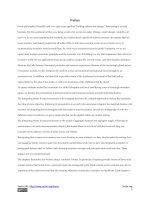Principles of macroeconomics 10e by case fair oster ch03
Bạn đang xem bản rút gọn của tài liệu. Xem và tải ngay bản đầy đủ của tài liệu tại đây (1.21 MB, 70 trang )
PRINCIPLES OF
MACROECONOMICS
PART I Introduction to Economics
TENTH
EDITION
CASE FAIR OSTER
© 2012 Pearson Education, Inc. Publishing as Prentice Hall
Prepared by: Fernando Quijano & Shelly Tefft
PART I Introduction to Economics
© 2012 Pearson Education, Inc. Publishing as Prentice Hall
2 of 70
Demand, Supply, and
Market Equilibrium
3
CHAPTER OUTLINE
Firms and Households: The Basic Decision-Making
Units
Input Markets and Output Markets: The Circular
Flow
Demand in Product/Output Markets
Changes in Quantity Demanded versus Changes in Demand
Price and Quantity Demanded: The Law of Demand
Other Determinants of Household Demand
Shift of Demand versus Movement Along the Demand Curve
From Household Demand to Market Demand
PART I Introduction to Economics
Supply in Product/Output Markets
© 2012 Pearson Education, Inc. Publishing as Prentice Hall
Price and Quantity Supplied: The Law of Supply
Other Determinants of Supply
Shift of Supply versus Movement Along the Supply Curve
From Individual Supply to Market Supply
Market Equilibrium
Excess Demand
Excess Supply
Changes in Equilibrium
Demand and Supply in Product Markets: A Review
Looking Ahead: Markets and the Allocation of
Resources
3 of 70
Firms and Households: The Basic Decision-Making Units
firm An organization that transforms resources (inputs)
into products (outputs). Firms are the primary
producing units in a market economy.
PART I Introduction to Economics
entrepreneur A person who organizes, manages, and
assumes the risks of a firm, taking a new idea or a new
product and turning it into a successful business.
households The consuming units in an economy.
© 2012 Pearson Education, Inc. Publishing as Prentice Hall
4 of 70
Input Markets and Output Markets: The Circular Flow
product or output markets The markets in
which goods and services are exchanged.
PART I Introduction to Economics
input or factor markets The markets in
which the resources used to produce goods
and services are exchanged.
© 2012 Pearson Education, Inc. Publishing as Prentice Hall
5 of 70
PART I Introduction to Economics
In the input, or factor markets, which side of the market do firms
and households occupy?
a.
Firms are on the supply side and households on the
demand side.
b.
Firms are on the demand side and households on the
supply side.
c.
Both firms and households are on the demand side.
d.
Both firms and households are on the supply side.
e.
Neither firms nor households are part of the demand side
or the supply side.
© 2012 Pearson Education, Inc. Publishing as Prentice Hall
6 of 70
PART I Introduction to Economics
In the input, or factor markets, which side of the market do firms
and households occupy?
a.
Firms are on the supply side and households on the
demand side.
b.
Firms are on the demand side and households on the
supply side.
c.
Both firms and households are on the demand side.
d.
Both firms and households are on the supply side.
e.
Neither firms nor households are part of the demand side
or the supply side.
© 2012 Pearson Education, Inc. Publishing as Prentice Hall
7 of 70
Input Markets and Output Markets: The Circular Flow
PART I Introduction to Economics
FIGURE 3.1 The Circular Flow of
Economic Activity
Diagrams like this one show the
circular flow of economic activity,
hence the name circular flow
diagram. Here goods and services
flow clockwise: Labor services
supplied by households flow to
firms, and goods and services
produced by firms flow to
households.
Payment (usually money) flows in
the opposite (counterclockwise)
direction: Payment for goods and
services flows from households to
firms, and payment for labor
services flows from firms to
households.
Note: Color Guide—In Figure 3.1
households are depicted in blue and
firms are depicted in red. From now on
all diagrams relating to the behavior of
households will be blue or shades of
blue and all diagrams relating to the
behavior of firms will be red or shades of
red.
© 2012 Pearson Education, Inc. Publishing as Prentice Hall
8 of 70
Input Markets and Output Markets: The Circular Flow
labor market The input/factor market in
which households supply work for wages to
firms that demand labor.
PART I Introduction to Economics
capital market The input/factor market in
which households supply their savings, for
interest or for claims to future profits, to firms
that demand funds to buy capital goods.
© 2012 Pearson Education, Inc. Publishing as Prentice Hall
9 of 70
Input Markets and Output Markets: The Circular Flow
land market The input/factor market in
which households supply land or other real
property in exchange for rent.
PART I Introduction to Economics
factors of production The inputs into the
production process. Land, labor, and capital
are the three key factors of production.
Input and output markets are connected through the behavior of
both firms and households. Firms determine the quantities and
character of outputs produced and the types and quantities of inputs
demanded. Households determine the types and quantities of
products demanded and the quantities and types of inputs supplied.
© 2012 Pearson Education, Inc. Publishing as Prentice Hall
10 of 70
PART I Introduction to Economics
Which of the following is supplied by households in factor
markets?
a.
Labor.
b.
Savings.
c.
Land.
d.
All of the above.
e.
None of the above.
© 2012 Pearson Education, Inc. Publishing as Prentice Hall
11 of 70
PART I Introduction to Economics
Which of the following is supplied by households in factor
markets?
a.
Labor.
b.
Savings.
c.
Land.
d. All of the above.
e.
None of the above.
© 2012 Pearson Education, Inc. Publishing as Prentice Hall
12 of 70
Demand in Product/Output Markets
A household’s decision about what quantity of a particular
output, or product, to demand depends on a number of
factors, including:
PART I Introduction to Economics
The price of the product in question.
The income available to the household.
The household’s amount of accumulated wealth.
The prices of other products available to the household.
The household’s tastes and preferences.
The household’s expectations about future income,
wealth, and prices.
© 2012 Pearson Education, Inc. Publishing as Prentice Hall
13 of 70
Demand in Product/Output Markets
PART I Introduction to Economics
quantity demanded The amount (number
of units) of a product that a household
would buy in a given period if it could buy
all it wanted at the current market price.
© 2012 Pearson Education, Inc. Publishing as Prentice Hall
14 of 70
Demand in Product/Output Markets
Changes in Quantity Demanded versus Changes in Demand
PART I Introduction to Economics
The most important relationship in individual markets
is that between market price and quantity demanded.
Changes in the price of a product affect the quantity demanded per
period. Changes in any other factor, such as income or
preferences, affect demand. Thus, we say that an increase in the
price of Coca-Cola is likely to cause a decrease in the quantity of
Coca-Cola demanded. However, we say that an increase in income
is likely to cause an increase in the demand for most goods.
© 2012 Pearson Education, Inc. Publishing as Prentice Hall
15 of 70
Demand in Product/Output Markets
Price and Quantity Demanded: The Law of Demand
demand schedule A table showing how
much of a given product a household
would be willing to buy at different prices.
PART I Introduction to Economics
demand curve A graph illustrating how
much of a given product a household
would be willing to buy at different prices.
© 2012 Pearson Education, Inc. Publishing as Prentice Hall
16 of 70
Demand in Product/Output Markets
Price and Quantity Demanded: The Law of Demand
PART I Introduction to Economics
TABLE 3.1 Alex’s Demand Schedule
for Gasoline
Price
(per Gallon)
Quantity Demanded
(Gallons per Week)
$ 8.00
7.00
6.00
5.00
4.00
3.00
2.00
1.00
0.00
0
2
3
5
7
10
14
20
26
FIGURE 3.2 Alex’s Demand Curve
The relationship between price (P) and quantity
demanded (q) presented graphically is called a
demand curve.
Demand curves have a negative slope, indicating that
lower prices cause quantity demanded to increase.
Note that Alex’s demand curve is blue; demand in
product markets is determined by household choice.
© 2012 Pearson Education, Inc. Publishing as Prentice Hall
17 of 70
Demand in Product/Output Markets
Price and Quantity Demanded: The Law of Demand
Demand Curves Slope Downward
PART I Introduction to Economics
law of demand The negative relationship
between price and quantity demanded: As
price rises, quantity demanded decreases;
as price falls, quantity demanded increases.
It is reasonable to expect quantity demanded to fall when price
rises, ceteris paribus, and to expect quantity demanded to rise when
price falls, ceteris paribus. Demand curves have a negative slope.
© 2012 Pearson Education, Inc. Publishing as Prentice Hall
18 of 70
PART I Introduction to Economics
Fill in the blanks. It is reasonable to expect that quantity
demanded will __________ when price rises, ceteris paribus, and
that demand curves have a __________ slope.
a.
rise; positive
b.
rise; negative
c.
fall; positive
d.
fall; negative
© 2012 Pearson Education, Inc. Publishing as Prentice Hall
19 of 70
PART I Introduction to Economics
Fill in the blanks. It is reasonable to expect that quantity
demanded will __________ when price rises, ceteris paribus, and
that demand curves have a __________ slope.
a.
rise; positive
b.
rise; negative
c.
fall; positive
d.
fall; negative
© 2012 Pearson Education, Inc. Publishing as Prentice Hall
20 of 70
Demand in Product/Output Markets
Price and Quantity Demanded: The Law of Demand
Other Properties of Demand Curves
1. They have a negative slope.
2. They intersect the quantity (X-) axis.
PART I Introduction to Economics
3. They intersect the price (Y-) axis.
The actual shape of an individual household demand curve—whether
it is steep or flat, whether it is bowed in or bowed out—depends on
the unique tastes and preferences of the household and other factors.
© 2012 Pearson Education, Inc. Publishing as Prentice Hall
21 of 70
PART I Introduction to Economics
That demand curves intersect both the price and the quantity axes
is a matter of common sense. Which of the following explains that
they intersect the price axis?
a.
Time limitations and diminishing marginal utility.
b.
Limited incomes and wealth.
c.
The law of demand.
d.
All of the above.
© 2012 Pearson Education, Inc. Publishing as Prentice Hall
22 of 70
PART I Introduction to Economics
That demand curves intersect both the price and the quantity axes
is a matter of common sense. Which of the following explains that
they intersect the price axis?
a.
Time limitations and diminishing marginal utility.
b.
Limited incomes and wealth.
c.
The law of demand.
d.
All of the above.
© 2012 Pearson Education, Inc. Publishing as Prentice Hall
23 of 70
Demand in Product/Output Markets
Other Determinants of Household Demand
Income and Wealth
income The sum of all a household’s wages, salaries,
profits, interest payments, rents, and other forms of
earnings in a given period of time. It is a flow measure.
PART I Introduction to Economics
wealth or net worth The total value of what a household
owns minus what it owes. It is a stock measure.
© 2012 Pearson Education, Inc. Publishing as Prentice Hall
24 of 70
Demand in Product/Output Markets
Other Determinants of Household Demand
Income and Wealth
normal goods Goods for which demand
goes up when income is higher and for which
demand goes down when income is lower.
PART I Introduction to Economics
inferior goods Goods for which demand
tends to fall when income rises.
© 2012 Pearson Education, Inc. Publishing as Prentice Hall
25 of 70









